“Something Perversely Pure”
The Resurrected Corpus of Ivo van Hove’s A View From the Bridge
Years of grudgingly reading their plays aloud in school had anesthetized me—or so I believed—to the Dead White Male Canon of Arthur Miller and his contemporaries. Masters of their craft these men may be, their works tend to endure stuck in time, like relics of zeitgeists gone by, with little metatextual variation despite the interpretations of countless actors, directors, and designers. However, the most recent incarnation of A View from the Bridge at the Lyceum Theater, directed by Belgian avant-gardist Ivo van Hove, slices through ossified flesh and bone to pierce the heart of the text. There are no trappings of tradition here, no extraneous elements (like sets, or props, or even shoes) to distract from the truth of the text. What this production achieves, then, is startling given the contradiction intrinsic to its existence: what catharsis arises from the collision of a play intractably rooted in a social context with a production that seeks total de-contextualization? How can Miller’s articulation of the struggles between person and polity in 1950s Brooklyn remain congruent with van Hove’s disavowal of subtext and insistence on deconstruction? The reconciliation of these two forces reminds us that theatre—as both an intellectual exercise and a collective human endeavor—is not endowed with one singular truth, but rather a multiplicity of meanings that thrive on the uniquely human impulse to create and explore.
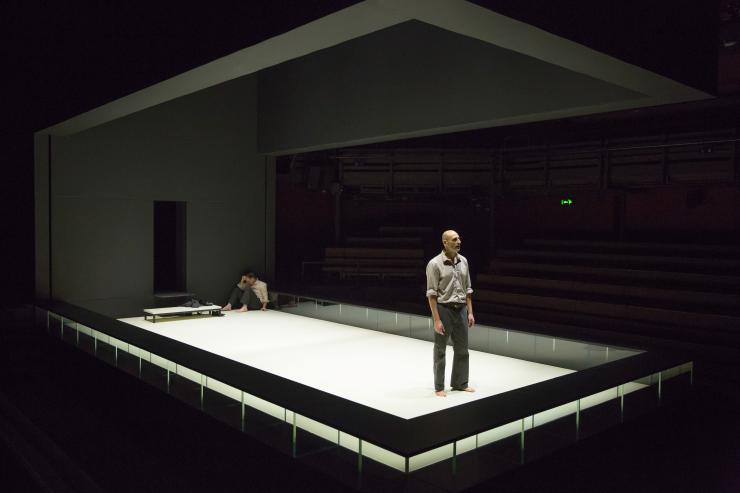
Within the four corners of the show’s stark white playing space—designed by longtime van Hove collaborator Jan Versweyveld, conjuring the image of a boxing ring—a laboratory of human behavior unfolds in which the actors reproduce a narrative in extremis that has no circumstantial beginning or end, no history, and no future. The drama simply exists on its own terms, as a sort of prism through which visions of theatrical theory are refracted. It is, like most other things about this production, fraught with contradiction: the experience of watching this View is at once clinical and cerebral, raw and visceral. Despite the monochromatic, minimalist design, and rigorously artificial playing conditions, this production is, above all, an explosion of human passions. The sanguinary deluge spelling Eddie’s death in the final scene is savage and primal, the manifestation of humanity reduced to its most elemental form.
This View is at once clinical and cerebral, raw and visceral. Despite the monochromatic, minimalist design and rigorously artificial playing conditions, this production is, above all, an explosion of human passions.
This corporeality is buttressed, too, by van Hove’s eschatological framework which figures A View from the Bridge as a ritualistic performance enacted by the dead. It opens with the thunderous strains of Fauré’s Requiem (a setting of the Catholic mass for the dead, traditionally performed in liturgical service) accompanying the ascension of the black box encasing the stage up into the flies, the sepulchral undertones of which are hardly coincidental. The players are provisionally resurrected from their tomb to present the drama, but there is no question of what will happen, only how—this conclusion has been ordained long before they even begin. “It’s like witnessing a car accident that you see a hundred meters before it happens,” van Hove once noted in an interview with The Guardian. “You just know they’re going to smash.” That the moment of catharsis, where two actors cleanse their bodies onstage, is situated at the very beginning of the performance suggests an arc resulting not in release, but in extinction—from ritual, regenerative purification in water to carnal desecration in blood; from birth to death.
The death of Eddie Carbone is not merely the death of one man, but the demise of a community; there is no victor in this struggle, only the fragmentation of bodies hitherto united.
And through this subversion of dramatic tradition emerges a conception of the body that distills Miller’s text into a single, corporeal truth. The death of Eddie Carbone is not merely the death of one man, but the demise of a community; there is no victor in this struggle, only the fragmentation of bodies hitherto united. How better to dramatize this synecdoche than as the literal embodiment of such a body politic? Van Hove lets Eddie and Marco briefly play out their confrontation, but ultimately they are subsumed into a teeming mass of performers huddled together onstage, only to reappear when Eddie has been inexplicably vanquished. Then the rafters rain crimson, imbruing the company-as-community with the indelible stain of his blood. Only after they’ve all been soaked does the mass finally fracture into individual bodies once more.
In his foreword to a recent edition of the play, Philip Seymour Hoffman wrote:
Miller has been said to be confronting the American Dream and its unattainable ideals. I’m sure he was, and I imagine it was quite personal. More specifically, though, he is bringing us uncomfortably close to the tragedy that arises not from our failures alone, but also—and especially—from our failures being laid bare, and laid bare by our own actions. […] I remember hearing the phrase “pulled inside out” to describe a man whose masculine exterior has been removed and all that remains is soft and sad and wailing. Eddie is that man, unprotected, revealed, us.
So perhaps the divergent forces of Miller and van Hove are in fact linked, both seized by the impulse to strip down, to reduce, to lay bare—Miller through the searing laceration of community and masculinity, van Hove through the rejection of orthodoxy and excess.
This instinct to lay bare extends to van Hove’s conception of the body, too, which is thrust into view in the prologue of his production. Mark Strong’s Eddie and Richard Hansell’s Louis are alone onstage together, washing themselves in a suffusion of soft orange light and rain from the veiled firmament above. In this View, where actors’ bodies are denied their conventional interactions with props and scenery and must instead rely on confrontation and collision with each other, the male body is simultaneously interrogated and exposed. Even the fit of Strong’s costume signals the conscious construction of masculinity within this world. Eddie is dressed in the same dull, nondescript attire as the rest of the company, but his clothes are loose and wrinkled where theirs are well tailored and finely pressed. Tight clothes are feminine, the implications of which Eddie makes every attempt to eschew; baggy clothes enlarge the body and lend Strong’s blustering physicality an air of casually potent masculinity. The voyeuristic baring of Eddie in View’s opening scene proffers his body as “soft and sad and wailing,” a shell that demands the protection of a masculine veneer. Only when this veneer is stripped away does the fragile masculinity—and male body—of Eddie Carbone begin to splinter and shatter.
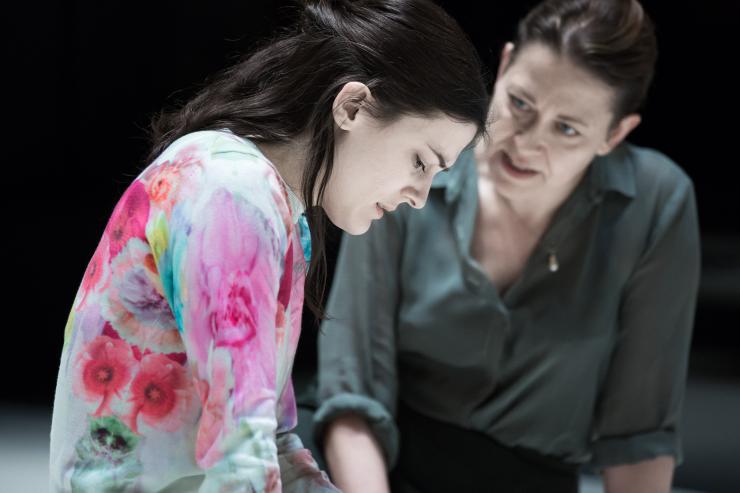
What happens to art, then, when it is stripped of its specificity, transmuted into an entirely different metatextual entity? Miller fashioned his play out of stories relayed directly by Brooklyn longshoremen, out of the European immigrant experience specific to mid-twentieth-century America. In van Hove’s View, that context is boiled down into blankness, in search of a universal truth, by divesting the play of external signifiers of identity. There are no shoes, no dinner table, no pasta, no bridge. This production does not exist in 1950s Brooklyn—drawing upon the rich and variegated history of immigration and Otherness in America—as per the playwright’s intentions, but rather in a sort of material vacuum. Here, truth is sought not in the authenticity of experience, but in its brazen artificiality.
Given the meticulous rigidity of the playing conditions, however, contravention of those rules must inevitably arise. If this production is totally divorced from historical reality and contemporary paradigms—if it exists solely in a theoretical void—then why is the entire cast (including understudies) white? If van Hove insists on the repudiation of naturalism, which would otherwise require a white cast to reproduce the reality of white Italian-Americans and Italian immigrants (the historicity of mixed-race and African Italians notwithstanding), surely the only theoretical logic underpinning this choice is the logic of white hegemony—for only whiteness can serve as default in this space of total cultural vacuity. And why do Beatrice and Catherine wear skirts and the men trousers, replicating gender binarism through fashion? Though Catherine’s skirt—how it simultaneously genders, infantilizes, sexualizes, and exposes her—carries a certain subtext in the production, that subtext is only rendered by the material reality of the skirt in normative Western culture. Why do Catherine’s high heels and Eddie’s cigar appear as real props onstage, too, while the dinner table and liquor bottles signified in Miller’s text never materialize despite sporting a similar subtextual weight? Why do the American characters use a reasonably accurate Brooklyn accent while the two Italian immigrants speak like Juilliard grads? Van Hove has remarked in several interviews that demanding Italian accents from his actors is too “theatrical,” that it detracts from the no-frills non-naturalism of the staging, but the incongruity of this “stage speaking” belies any sort of consistency in the linguistic realm of his direction.
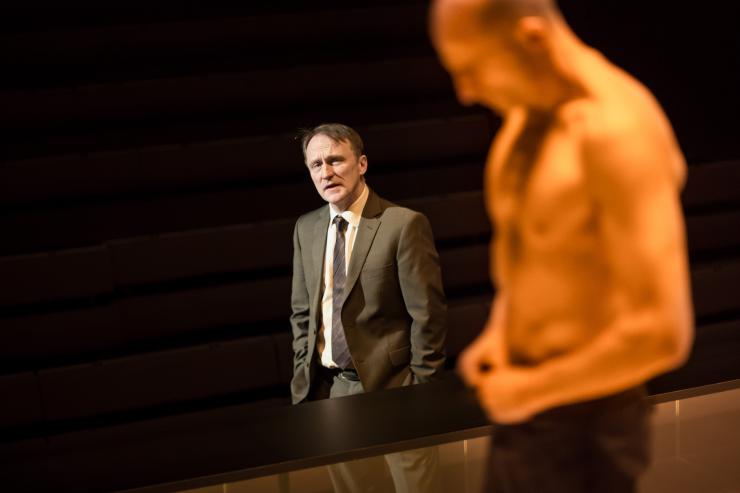
These are merely holes in the fabric of van Hove’s theatrical reality, not tangles in the skein of it, and certainly there is something to be said for an approach that rescues classic plays from the calcification of tradition, particularly one as seminal and oft-produced as A View from the Bridge. Yet the dissolution of a text from its specific context seems irreconcilable with artistic practice and, indeed, with social responsibility. Miller’s View is a political play—not so much in its promotion of a certain dogma or doctrine, but in that it effectively reproduces the experience of being a human being who exists within a polity and interacts with groups created by the formation of political boundaries. A View from the Bridge as devised by van Hove, however, aims for pure artistic integrity in an apolitical void.
As Brecht once said, “for art to be ‘un-political’ means only to ally itself with the ruling group.” While this View does not deliberately engage with political discourse on a subtextual level, its politics are decidedly conventional—conservative, even. There are no attempts to subvert gender paradigms, no casting choices that accurately reflect the racial composition of London (the production’s birthplace) or New York (its current home), no exploration of the latent queerness arguably manifest in Eddie Carbone. In the absence of political or cultural engagement, then, van Hove propels A View from the Bridge from the realm of the specific to the universal, where it comes to occupy a different kind of discursive space in the process. “Miller himself considered it a Greek tragedy,” van Hove remarked in a recent Vogue interview, “and I wanted to really focus on the fact that these characters should represent humanity, all of us. I wanted to look into their souls.”
Though his production may not satisfy or elucidate every single facet of Miller’s play, this View from the Bridge is a testament to the versatility of classic texts and the power of reinvention, as well as to the infinite possibilities of theatre itself.
Thus Miller’s decades-old text and van Hove’s postmodern dramaturgy coalesce in the austerity and ubiquity of Greek tragedy. What was once a story about a specific time and place, entrenched in a specific cultural experience, now becomes a fatalistic fable in which humanity itself stands trial. The experience of watching this story is no longer about receiving, but about projecting—the only truth is in the text, and whatever else may be gleaned from the performance is specific to each individual theatregoer. In conferring the meaning of the play on the audience, whose own particular subtext and context substitute for the lack hereof, van Hove produces a theatrical experience with undeniable roots in Brecht and a keen eye towards the future. Though his production may not satisfy or elucidate every single facet of Miller’s play, this View from the Bridge is a testament to the versatility of classic texts and the power of reinvention, as well as to the infinite possibilities of theatre itself.


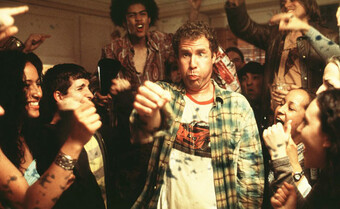



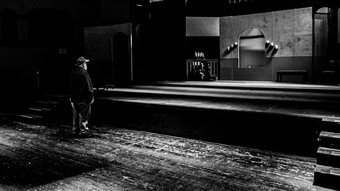


Comments
The article is just the start of the conversation—we want to know what you think about this subject, too! HowlRound is a space for knowledge-sharing, and we welcome spirited, thoughtful, and on-topic dialogue. Find our full comments policy here
"There are no trappings of tradition here, no extraneous elements (like sets,
or props, or even shoes) to distract from the truth of the text." . . . . Really? I don't know where to even begin with this.